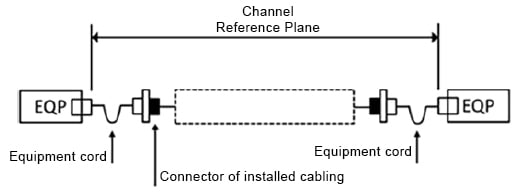白皮书
阐明光纤测试方法 – 回归根本
下载 PDF
本页内容
Fiber Optic Cable Testing Methods
Fiber optic networks are the backbone of modern telecommunications, providing high-speed data transmission over long distances with minimal loss. The performance and reliability of these networks depend on the quality of the fiber optic cables and the precision of their installation. This is why fiber optic cable testing is critical.
Fiber optic testing ensures the performance and reliability of fiber optic networks. These test procedures assess the physical and functional qualities of fiber optic cables, connectors, and the network as a whole. Key tests include:
- Measuring signal loss
- Verifying the strength and quality of the fiber
- Ensuring compliance with industry standards
Effective fiber testing utilizes advanced tools such as Optical Loss Test Sets (OLTS), Optical Time-Domain Reflectometers (OTDR), and Visual Fault Locators (VFL) to diagnose and correct issues, ensuring optimal network performance. Such a comprehensive approach to fiber optic cable testing safeguards the integrity of data transmission.
Fluke Networks provides comprehensive solutions for fiber optics testing, ensuring your network performs at its optimal level.
What Is Fiber Testing?
Fiber testing evaluates fiber optic cables' performance characteristics and integrity. It verifies the functionality and efficiency of newly installed and existing fiber optic networks. Careful and comprehensive fiber optics testing helps technicians detect issues such as signal loss, interference, and physical damage to the cables, any of which can severely impact network performance.
What Are the Methods of Fiber Testing?
There are several methods of fiber optic cable testing, each serving a specific purpose in assessing the cable's performance and reliability:
- Optical Loss Test Sets (OLTS): This method measures the total light loss in a fiber optic link, simulating the network conditions.
- Optical Time-Domain Reflectometer (OTDR): OTDR testing involves sending pulses of light down the fiber to detect faults, bends, and splice losses by analyzing the light scattered or reflected.
- Visual Fault Locator (VFL): VFLs use a visible light laser to identify breaks and tight bends in the fiber optic cable.
- Fiber Inspection Probes: These devices magnify the end face of a fiber connector, allowing technicians to find dirt, debris, or damage that could impede performance.
What Are the Standards for Fiber Optic Cable Testing?
Industry standards in fiber optic cable testing are crucial for ensuring a fiber optic network’s consistency, reliability, and interoperability. The key standards organizations include:
- TIA/EIA: Sets standards for fiber optic cable system design, installation, and testing in North America.
- IEC: Sets international standards covering various fiber optics testing procedures and parameters.
- ISO: Provides quality management and assurance standards, including those relevant to fiber optic testing.
What Are the Different Types of Fiber Optic Cable Testing?
Fiber optic cable testing can be categorized based on the type of test being conducted:
- End-to-End Testing: Verifies light transmission capability and signal integrity over the entire length of the cable.
- 光时域反射计 (OTDR) 测试:Identifies the location and severity of faults within the cable or its connectors.
- Insertion Loss Testing: Measures the loss of signal power resulting from the insertion of a device in a transmission path.
- Return Loss and Reflectance Testing: Assesses the amount of light reflected back toward the source, which can cause signal degradation.
永久链路与信道
永久链路参考平面包括已安装光纤的衰减和两端接头的衰减。链路可能含有其他连接和接头。因为测量基准或衰减时未使用设备线,所以不包含设备线的衰减(见图 1)。

图 1. 永久链路参考平面
永久链路参考平面包括安装的光纤、连接、接头的衰减和设备线与已安装线缆(在大部分情况下是永久链路)之间的衰减。信道不包含与设备连接的设备线接头的衰减(见图2)。

图 2. 信道参考平面
线缆配置
线缆配置可能是以下已知形态:
- 适配器或接头位于线缆两端
- 插头位于线缆两端
- 插头位于线缆一端,适配器位于线缆的另一端
- 插头位于线缆两端,通过设备接线连接
有五种特殊的测试方法可用于测试四种线缆配置:
- 单线方法
- 双线方法
- 三线方法
- 增强三线方法
- 设备线或信道方法
单线方法用于链路测试,需要将发射线直接连接到功率计作为参考,然后假定功率计有可更换的适配器。测试的线缆两端有适配器或接头时,即使用这种方法。单线方法是优先选用的方法,因为它的测量不确定性很低。
双线方法用于链路测试,可用于双线配置。首先,线缆两端都有插头时。其次,线缆一端有插头另一端有适配器时。双线方法测量的是线缆,但仅测量一端的连接。
三线方法不包括所测线缆两个连接的衰减。尾纤拼接到线缆两端并直接连接到传输设备时可以使用。如果没有更好的方法,此方法也可用于信道测试。
增强三线方法包括所测线缆两个连接的衰减,可用于链路测量。线缆两端接头不同时,会难以使用单线方法,此时即可使用此方法。
如果设备线安装在线缆两端并等待连接到传输设备,即可使用设备线/信道测试方法。此方法用于信道衰减测量。与三线方法相比,此方法不确定性较低,但更难使用。
表 1 总结了已安装光纤布线的已知衰减测量标准、测试方法,更重要的事项,以及何时使用。仔细研究表格后可发现标准之间有重叠。只有一个标准中指定的正确测试方法即为增强三线方法。
| 根据标准定义的测试方法 | |||
|---|---|---|---|
| 标准 | 测试方法 | 使用时 | 注释 |
| TIA-526-14-C,由 IEC61280-4-1改编,版本2 | 单线 | 线缆两端插头或接头连接了适配器时所需的测试方法。 | |
| 双线 | 线缆两端使用混合接头(一端连接适配器,另一端使用插头)的链路所需的测试方法 | ||
| 三线 | 线缆两端使用插头的链路所需的测试方法。 | ||
| IEC 61280-4-1,修订中的版本3 | 单线 | 线缆两端插头或接头连接了适配器时所需的测试方法。 | 假定功率计上的接头兼容连接发射电缆的待测线缆(功率计有可更换的适配器)。 |
| 双线 | 线缆两端有插头的链路所需的测试方法;线缆两端使用混合接头(一端连接适配器,另一端使用插头)的链路所需的测试方法 | ||
| 三线 | 作为单线、三线和设备线方法备用方法的链路测试。 | ||
| 设备线 | 使用设备线的线缆两端有插头的链路所需的测试方法 | 大部分情况下是单线方法的变体。 | |
| TIA-526-7,使用 IEC 61280-4-2,版本 2 | 单线 | 线缆两端插头或接头连接了适配器时所需的测试方法。 | 直接使用,不改编,IEC 61280-4-2 的内容相同。 |
| 双线 | 线缆两端使用混合接头(一端连接适配器,另一端使用插头)的链路所需的测试方法 | ||
| 三线 | 线缆两端使用插头的链路所需的测试方法。 | ||
| TIA-568,3-D | 根据 TIA 526-7 和 TIA 526-14 中的说明。 | 信道测试应使用 IEC 标准而非 ISO/IEC 测试标准说明的三线方法。 | 单线方法是多模和单模链路的首选。 |
| ISO/IEC 14763-3,版本 2 | 单线 | 待测线缆接口与功率计相同时的链路衰减;测量永久链路。 | 修订中 |
| 增强三线 | 待测线缆两端接口不同时的链路衰减;测量永久链路。 | ||
| 信道 | 使用设备(客户)线的信道衰减不包括到设备(接收器)的连接;测量信道。 | ||
| ARINC 805 | 多模和单模用单线 | 需要的测试方法 | 根据 TIA-526-7(SM) 和 TIA-526-14(MM) |
永久链路测试包括电缆两端的两个连接衰减的测试。信道测试不包括设备线和收发器之间的连接衰减。
单线方法
a. 使用发射光纤在光源和功率计之间设置参照(见图 3)。

图 3. 设置参照
a. 在功率计上连接一根接收光纤。
b. 将发射光纤和接收光纤连接到待测线缆(见图 4)。
c. 进行测量并与参照测量对比

图 4. 测量线缆衰减,A 连接,和 B 连接
双线方法
a. 使用发射光纤和接收光纤在光源和功率计之间设置参照(见图 5)。

图 5. 设置参照
b. 进行测量并与参照测量对比(见图 6a 和图 6b)。
c. 对于案例 2,适配器线成为发射光纤的一部分(见图 6b)

图 6a. 测量案例 1 的衰减(插头适配器和线缆末端有插头)

图 6b. 测量案例 2 的衰减(线缆两端有接头)
三线方法
a. 使用发射光纤、替换线和接收光纤在光源和功率计之间设置参照(见图 7)。

图 7. 设置参照
a. 取下替换线并使用待测线替换。
b. 进行测量并与参照测量对比(见图 8)。

图 8. 测量衰减
增强三线方法
a. 使用发射光纤在光源和功率计之间设置参照(见图 9)。

图 9. 使用单线设置参照
a. 为功率计添加接收光纤并在发射和接收光纤之间添加替换线,然后检查低损耗连接,例如单模的 0.4 dB(见图 10)。

图 10. 检查低损耗连接
a. 取下替换线并使用待测线替换。
b. 测量线缆衰减并与参照对比(见图 11)。

图 11. 测量衰减
设备线,信道测试方法
a. 使用连接到光源的发射光纤和第一根设备线设置参照(见图 12)。

图 12. 设置参照
a. 在功率计上连接第二根设备线。
b. 将设备线连接到线缆并测量衰减(见图 13)。

图 13. 测量衰减
总结
了解永久链路和信道之间的差异是很难的事情,了解要使用哪种测试方法也是很容易混淆的事情,特别是混合配置的情况。这些混合配置是确实存在的,了解如何测试它们可以为安装者带来优势。测试时有许多标准可以使用,但测试方法的标准也有重叠的部分。表 1 简单说明了各种标准,应该使用哪种测试方法,以及应该根据线缆配置选择哪种方法。尽管还有其他测试方法,但 Fluke Networks 建议为所有测试使用单线方法。
Learn more about fiber optic testers, tools, and troubleshooting on our Fiber Optic Testers page.




